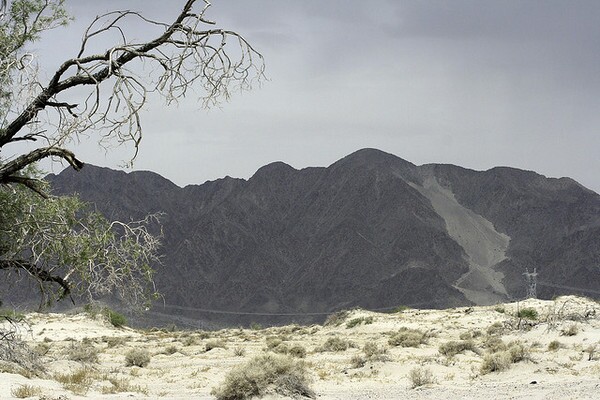Another Solar Plant Proposed Near Mojave National Preserve

The "Cronise Cat," a hanging dune upwind of the proposed Caithness Soda Mountains PV plant | Photo: Chris Clarke
A 350-megawatt solar electric generating facility that would use 1.5 million photovoltaic panels is being proposed for nearly 4,400 acres adjacent to the northwest corner of the Mojave National Preserve. The Caithness Soda Mountain Solar Project would straddle Interstate 15 in an undeveloped area southwest of Baker, California between the Zzyzx Road and Rasor Road off-ramps, its northern unit filling most of a mile-wide swath between the Preserve and the Soda Mountains Wilderness Study Area.
Project owner Caithness is a diversified energy company, whose largest U.S. renewable energy project is the 909-megawatt Shepherds Flat Wind Farm in eastern Oregon. The company owns wind and geothermal facilities in the California desert.
The area surrounding the proposed project site, part of the complex of dry lakes and sand transport corridors surrounding the Mojave River terminus at Soda Lake, is almost entirely undeveloped. Aside from the Interstate 15 corridor, remote service stations at Rasor Road and Afton Road, and the Rasor Road off-road vehicle area, the stretch of land along the interstate between Afton Canyon and Baker might as well be an extension of the Mojave National Preserve, at least as far as visual resources are concerned.
There is a transmission corridor crossing the site that contains two transmission lines, one of which would be able to carry the power generated by the project. As that line is owned by LADWP, Caithness would focus its power purchase agreement efforts on members of the Southern California Public Power Authority, a consortium of public utilities to which LADWP belongs. To sell to other California utilities, Caithness would need to build substantial new transmission. The other line crossing the site, CaISO's Eldorado-Mountain Pass-Baker-Dunn Siding-Coolwater-Kramer line, is already at capacity.
The project's Plan Of Development (POD) mentions the sandy nature of the local soils in a discussion of whether the project would constitute a threat to habitat of the Mojave fringe-toed lizard. The POD doesn't mention the effect the area's persistent wind-blown sand might have on photovoltaic efficiency. The area's sand gets blown around persistently enough that hanging dunes dot the area: dunes where sand is actually blown up the side of mountain ranges and tumbles down the far side. It would be interesting to see an analysis of how well the project's chosen crystalline silicon PV cells will stand up to what may be near-constant sandblasting.
Caithness's POD maintains that there aren't Mojave fringe-toeds in the area, but the region is a known refuge for desert bighorn sheep, which are often seen along Zyzzx Road south of Interstate 15.
The project would be sited entirely on public lands administered by the Bureau of Land Management. The BLM will be overseeing the project's environmental assessment under the National Environmental Policy Act, and is now accepting the usual scoping period comments to influence the scope of the eventual Environmental Impact Report. Comments will be accepted until November 23, 2012.
ReWire is dedicated to covering renewable energy in California. Keep in touch by liking us on Facebook, and help shape our editorial direction by taking this quick survey here.


